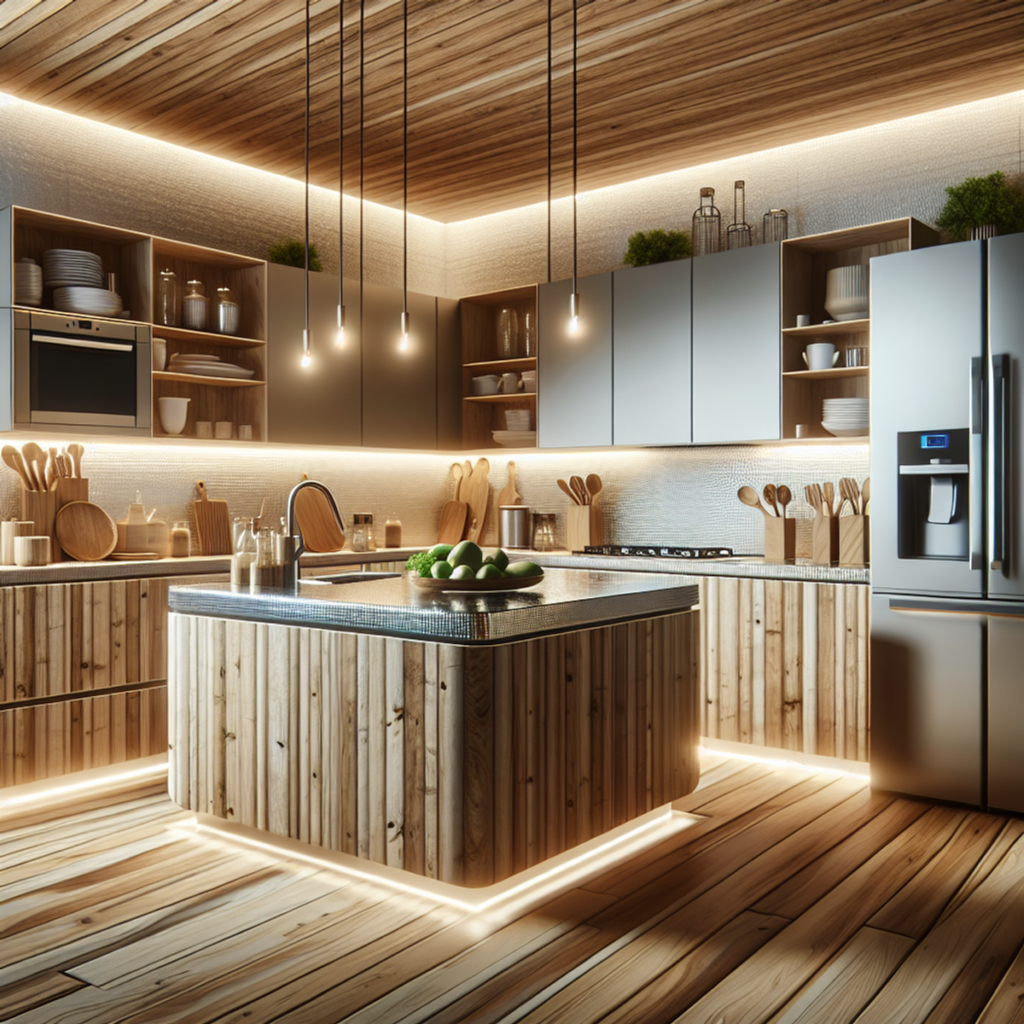
Table of Contents
Planning a San Diego home renovation? Let’s talk about sustainable kitchen materials. Sustainability is more than just a buzzword, it’s a way to make our homes better for the planet and for us.
Sustainable materials are those that have minimal impact on the environment during their production, use, and disposal. They are typically made from renewable resources and are often recyclable or biodegradable. When it comes to kitchen remodeling in sunny San Diego, choosing sustainable materials can help reduce your carbon footprint while delivering a gorgeous new look.
There’s an added bonus to going green in your kitchen remodel: Improved indoor air quality! Many traditional building materials emit Volatile Organic Compounds (VOCs), which can cause health problems. But many eco-friendly options are low-VOC or even VOC-free, so you can breathe easier in your new kitchen.
So let’s explore some of the best sustainable kitchen materials for your San Diego home renovation. You’ll be amazed at how good green can look!
1. Environmentally Friendly Cabinets
Making your kitchen remodel eco-friendly starts with selecting sustainable cabinet materials. This not only brings you closer to a green lifestyle but also adds a unique aesthetic charm to your kitchen.
1.1 MDF (Medium Density Fiberboard)
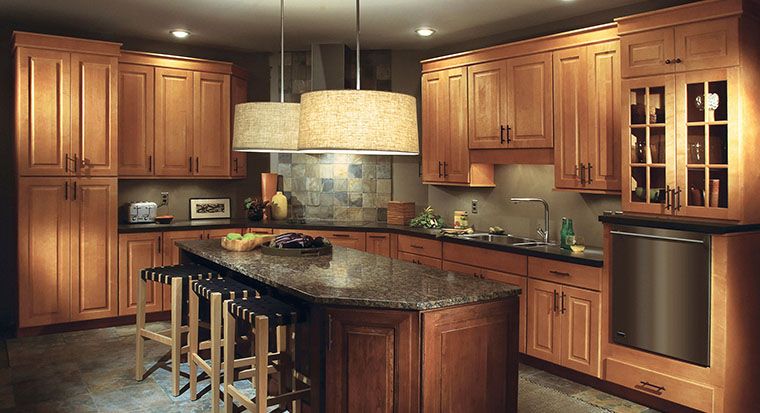
If you’re looking for an eco-friendly solution that doesn’t compromise on durability, MDF or Medium-Density Fiberboard is the answer.
MDF is a type of engineered wood made from recycled hardwoods and softwoods. It’s created by breaking down these woods, mixing them with resin, and then pressing them into flat panels under high temperature and pressure. This production method ensures that every part of the tree is used, reducing waste and making MDF a smarter choice for our environment.
But going green doesn’t mean settling for lower quality. MDF is known for its strength and durability, making it perfect for kitchen cabinets that can withstand daily use and still look fantastic. Another great thing about this material is its versatility. With MDF, you can achieve any desired look – whether it’s contemporary chic or rustic charm – thanks to its smooth surface that takes well to paints and finishes.
1.2 Bamboo

Moving away from traditional materials like MDF, let’s talk about a more unique and sustainable option for kitchen cabinets – bamboo. Bamboo, often associated with pandas and Asian landscapes, has been gaining popularity in the home remodeling industry. Why? It’s simple! This grass (yes, it’s not a tree but a grass) offers special benefits that make it an excellent choice for eco-friendly cabinet materials.
1.2.1 Rapid Renewability
One of the top reasons why bamboo is considered eco-friendly is its incredibly fast growth rate. Unlike hardwood trees that take decades to mature, bamboo shoots reach their full height in just six months and become fully mature in about five years. This quick renewability helps reduce strain on forests, making a significant contribution to sustainability efforts.
1.2.2 Strength and Durability
But the advantages of bamboo cabinet material go beyond its growth speed. Bamboo is also exceptionally strong and durable – even more so than certain hardwoods! It can handle the busy activity of your San Diego kitchen without showing signs of damage. Additionally, bamboo is resistant to both moisture and heat, which are crucial factors to consider for kitchens with high humidity levels.
1.2.3 Unique Aesthetic Appeal
Another great thing about bamboo is its distinctive visual appeal. Its natural grain patterns bring an exotic atmosphere to your kitchen, making it perfect for achieving a contemporary or modern look. Whether you prefer the light tones of natural bamboo or the darker tones of carbonized bamboo, there’s an option available to suit your style preference.
1.2.4 Shopping Tips: Formaldehyde-Free Glues
When shopping for bamboo cabinets, it’s essential to look for products that use formaldehyde-free glues during the manufacturing process. Some manufacturers may use harmful adhesives when pressing the bamboo together, which can release toxins into your home over time. Prioritizing formaldehyde-free options ensures better indoor air quality and a healthier living environment for you and your family.
Key Takeaways:
- Bamboo is a rapidly renewable resource, maturing much faster than traditional hardwoods.
- Known for its strength and durability, bamboo can withstand high-traffic kitchen environments.
- The unique aesthetics of bamboo can add a modern touch to your kitchen.
- Always look for formaldehyde-free bamboo products to ensure indoor air quality.
1.3 NuGreen Particleboard: A Sustainable Choice for Kitchen Cabinets
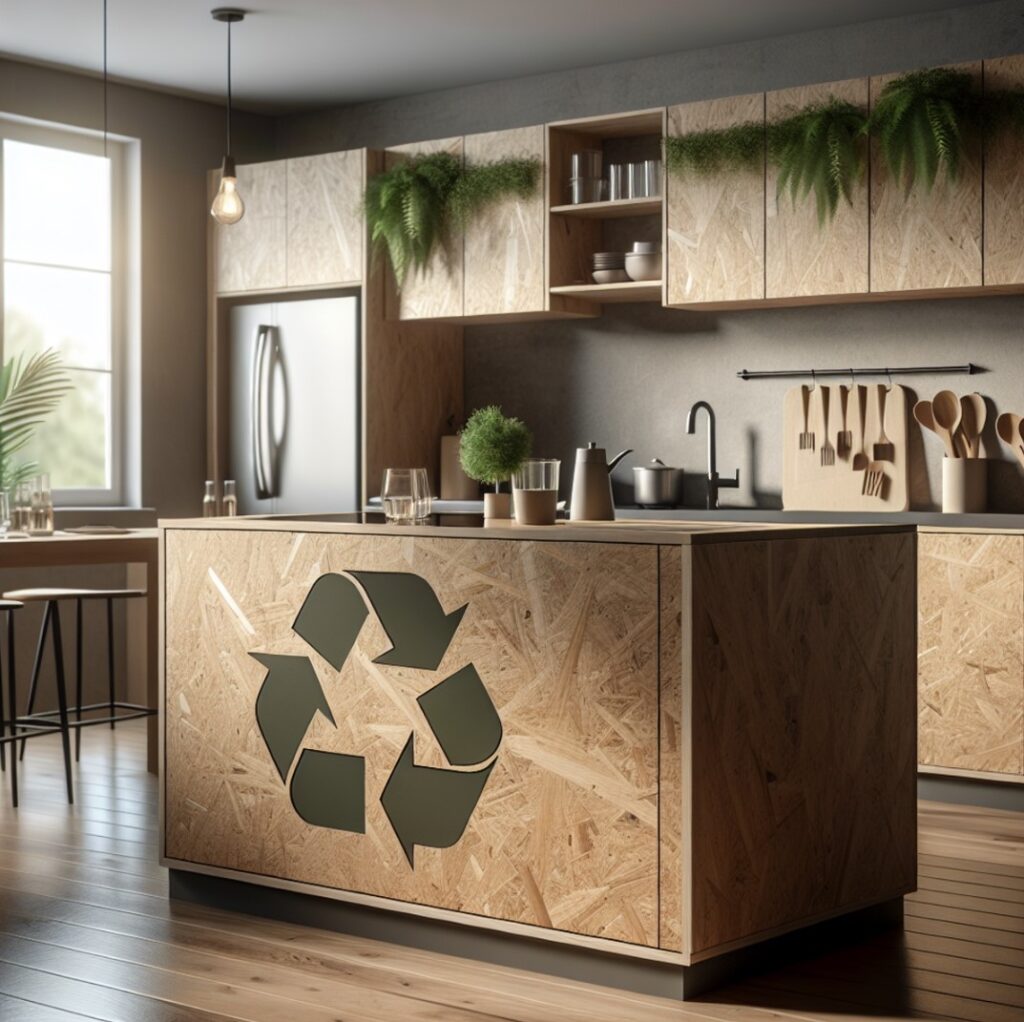
When it comes to eco-friendly cabinet materials, NuGreen particleboard stands out as a smart and sustainable choice. It’s an innovative product that combines the desire for style and the need for environmentally responsible materials. Here’s why NuGreen particleboard is gaining popularity in kitchen remodels:
1. Recycled Wood Fibers
At the heart of NuGreen particleboard lies its composition of recycled wood fibers. This means it directly utilizes post-industrial waste, which would otherwise end up in landfills. By giving new life to these materials, NuGreen particleboard plays a significant role in waste reduction efforts.
2. Low Formaldehyde Emissions
A major concern with traditional wood products has been the emission of formaldehyde, a volatile organic compound (VOC) known for its adverse health effects. NuGreen particleboard addresses this issue head-on by meeting stringent standards for low formaldehyde emissions, contributing to better indoor air quality in your home.
3. Versatility in Design
Just like MDF and bamboo, NuGreen particleboard doesn’t lag when it comes to design versatility. Whether you’re after a contemporary look or something more traditional, this material can be tailored to fit your vision, making it a favorite among designers and homeowners alike.
4. Durability
Kitchen cabinets need to withstand daily wear and tear, and NuGreen delivers on this front too. It’s engineered for strength and longevity, ensuring that your kitchen not only looks good but also stands up to the hustle and bustle of daily life.
5. Sustainable Certification
For those who seek proof of sustainability credentials, NuGreen particleboard ticks this box as well. It often comes with certifications from recognized environmental organizations, assuring you that your choice supports sustainable forestry practices.
Pairing NuGreen cabinets with water-based paints and stains further enhances the eco-friendliness of your kitchen. These coatings minimize VOC emissions compared to solvent-based options and are easier on the environment when it comes to disposal.
1.4 Water-Based Paints and Stains
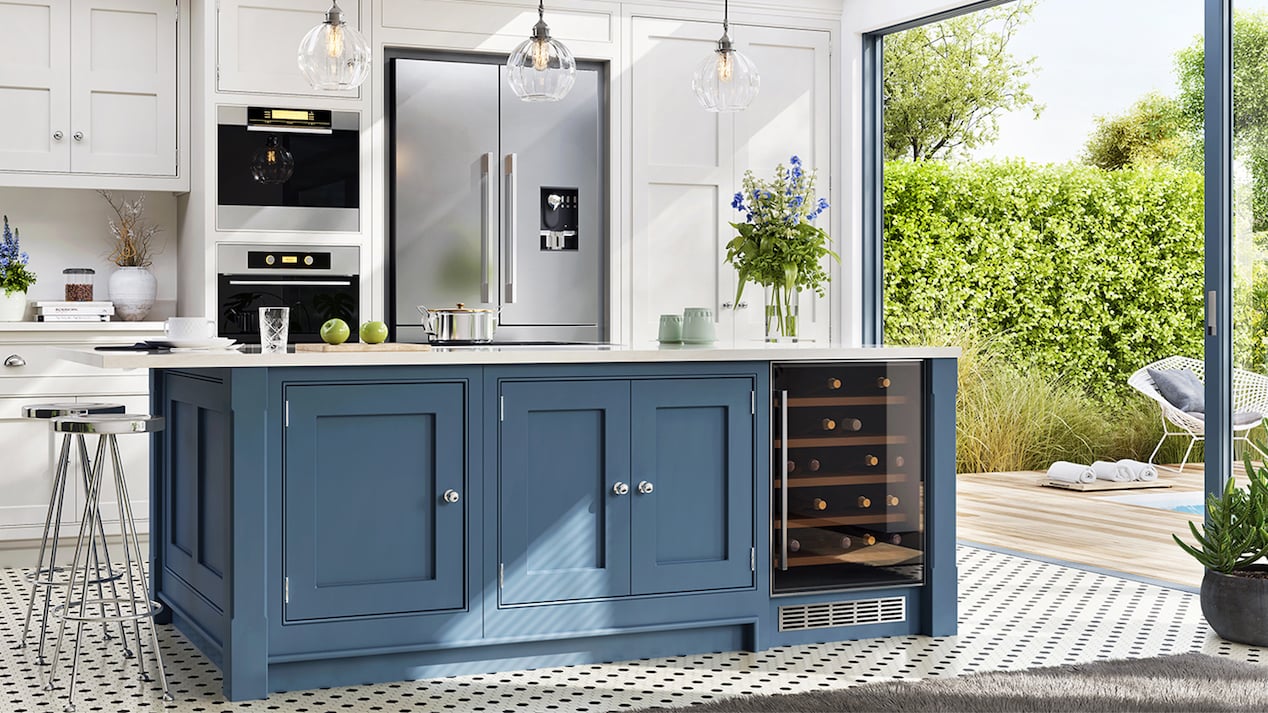
When it comes to eco-friendly cabinet materials like MDF, bamboo, and NuGreen particleboard, the finishing touches can make all the difference. This is where water-based paints and stains come into play, offering a sustainable option for those looking to complete their cabinet designs while maintaining an environmentally conscious approach.
Advantages of Water-Based Paints and Stains:
- Reduced VOC Emissions: Volatile Organic Compounds (VOCs) are chemicals that can easily evaporate at room temperature and negatively impact indoor air quality. Water-based paints and stains contain lower levels of VOCs compared to their solvent-based counterparts, which means they contribute less to air pollution and are safer for your family’s health.
- Easier Cleanup and Disposal: Cleaning up after using water-based products is a breeze—no need for harsh chemicals since water can do the job. This not only simplifies the process but also means that disposal is less of an environmental concern.
- Quick Drying Time: Water-based finishes tend to dry quicker than solvent-based options. This can help speed up renovation projects and reduce the time your kitchen is out of commission.
- Less Odor During Application: Nobody likes the strong smell associated with painting or staining cabinets. With water-based options, you’ll notice a significant reduction in odor during application, which makes for a more pleasant remodeling experience.
- Durability: In the past, there was a misconception that water-based products were not as durable as solvent-based ones. However, advances in technology have led to high-quality water-based finishes that provide excellent durability and resistance to wear.
Using water-based paints and stains for cabinet finishes align with San Diego’s eco-friendly lifestyle. Not only do these products help you create a beautiful kitchen aesthetic, but they also support your commitment to sustainability.
By choosing these green options for your cabinets’ finish, you’re making a choice that benefits both your home environment and the planet. It’s a win-win situation: achieving that stylish look without compromising on your ecological values.
With all these advantages in mind, it’s clear why water-based paints and stains are becoming increasingly popular among homeowners who are keen on green living—and why they’re an excellent match for the eco-friendly cabinet materials already discussed.
2. Eco-Friendly Countertop Options
2.1 PaperStone (Recycled Paper)
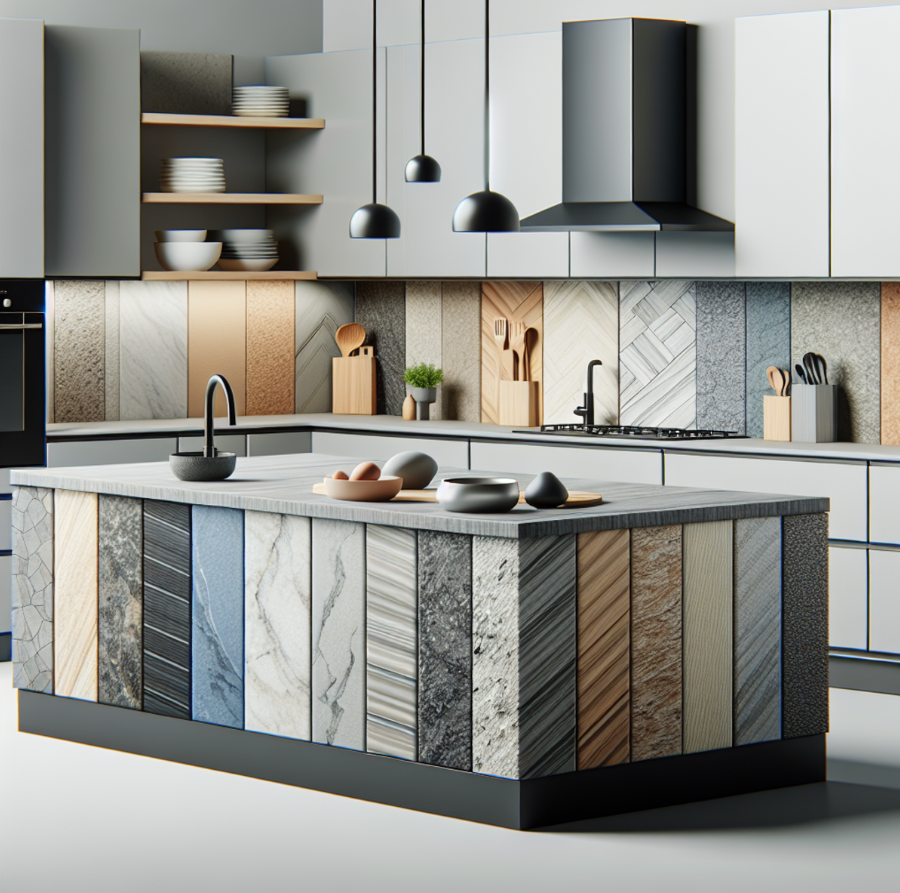
A trendy name that’s been making waves in the realm of sustainable kitchens is PaperStone. No, it doesn’t involve papier-mache or origami! This remarkable product is a type of countertop material made primarily from recycled paper – hence the name.
The concept may sound a bit outlandish, but rest assured, PaperStone is as sturdy and durable as it gets. This innovative material is created by compressing layers of recycled paper into a dense, solid form. A non-petroleum resin is used to bind everything together, creating a hard surface that can withstand the rigors of daily kitchen use.
Here’s an interesting fact: The environmental benefits of using PaperStone are not just limited to its recycled content. Since it’s made from paper, this material is essentially renewable and can be replaced over time without depleting natural resources.
Despite being lightweight and easy to handle, PaperStone offers exceptional durability and resistance against scratches, heat, and stains – all qualities that are highly coveted in a kitchen countertop material. Plus, it’s available in various colors to suit any design aesthetic.
What about maintenance? Well, much like other countertop materials, PaperStone requires some care to maintain its beauty and longevity. Regular sealing is recommended to preserve its color and prevent staining. However, it’s worth noting that minor scratches can easily be sanded out due to the material’s solid color all the way through.
So there we have it – PaperStone. A unique blend of sustainability and functionality that promises to add a touch of eco-friendly charm to your San Diego home kitchen.
2.2 IceStone (Recycled Glass and Concrete)
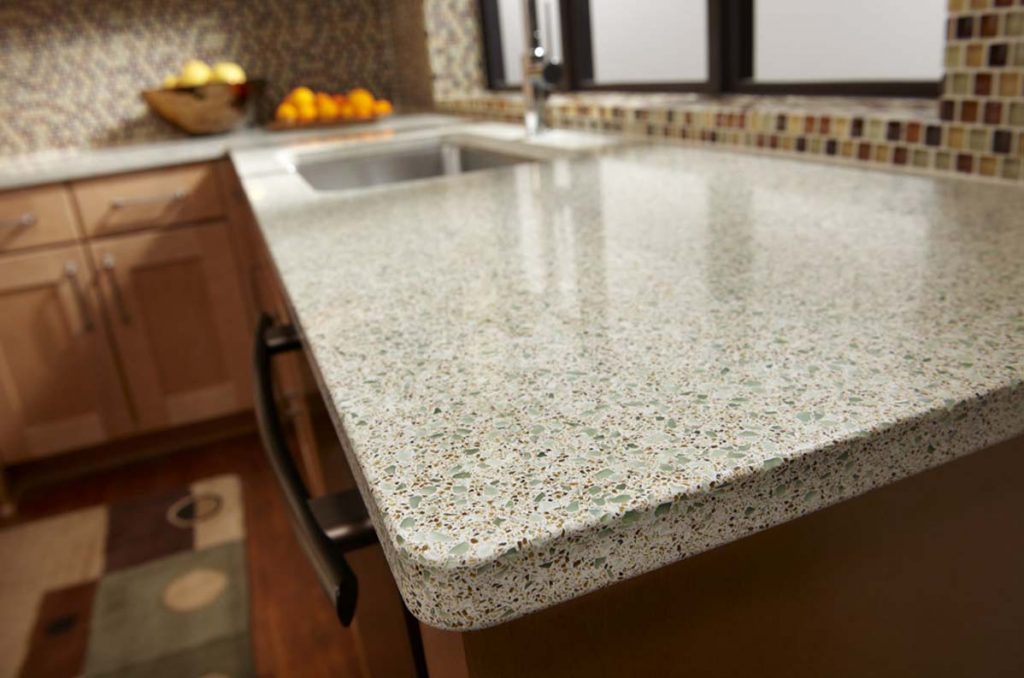
San Diego homes are increasingly embracing sustainable materials in their kitchens, and one standout option is IceStone. Made from a blend of recycled glass and concrete, this countertop material not only supports an eco-friendly lifestyle but also brings a unique aesthetic to the table.
Advantages of IceStone:
- Eco-Friendly Composition: The core of IceStone’s appeal lies in its environmental credentials. By using recycled glass, which would otherwise end up in landfills, it gives new life to materials that are often discarded. The concrete used is also mixed with non-toxic pigments and binders, making it a safer choice for the home environment.
- Durability: Despite its recycled content, IceStone does not compromise on strength. It stands up well to daily kitchen demands, resilient against most scratches and stains when properly sealed.
- Design Versatility: With a wide spectrum of colors and patterns available, IceStone countertops can be tailored to fit any design scheme. Whether your taste leans towards bold and contemporary or subtle and classic, there’s an option to match.
IceStone’s Design Possibilities:
- Customization: Homeowners can choose from a variety of shades and flecks of glass that reflect light differently, providing a unique element that can’t be replicated with other materials.
- Finishes: Matte or glossy, textured or smooth; the finish on an IceStone countertop can dramatically alter the look and feel of your kitchen space.
- Integration: This material pairs beautifully with both modern appliances and more traditional design elements, bridging the gap between various kitchen styles seamlessly.
Choosing IceStone for your San Diego kitchen remodel means opting for a surface that is as kind to the planet as it is striking in appearance. Its combination of sustainability and style makes it a compelling choice for homeowners who are looking to make a statement while staying committed to eco-friendly practices.
Remember to consult with professionals regarding the proper care and maintenance of your IceStone countertop to ensure its longevity and preserve its beautiful finish. With proper care, this recycled glass countertop material can serve as a functional centerpiece in your sustainable San Diego home for years to come.
2.3 Dekton (Sintered Surface)
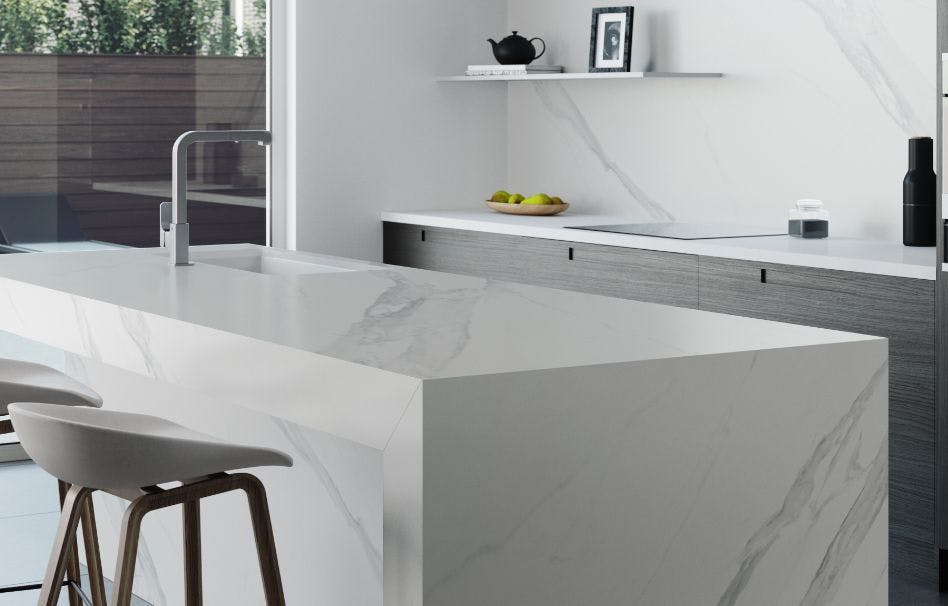
When you’re planning a kitchen remodel, it’s important to think beyond just aesthetics. You want materials that not only look good but also stand the test of time, function well, and have a positive impact on the environment. Dekton, a sintered surface countertop material, fits the bill perfectly.
Durability That Shines
Dekton is created by Cosentino and is widely recognized for its exceptional strength. What sets it apart? This countertop material is specially designed to resist damage from UV rays – a crucial feature for homes in sunny San Diego that receive plenty of natural light! Unlike some other options, Dekton won’t lose its color or quality over the years due to sun exposure.
But that’s not all – Dekton goes above and beyond when it comes to durability. It’s highly resistant to both scratches and stains, making it an ideal choice for busy kitchens. Whether you’re chopping ingredients, preparing dough, or accidentally spilling wine, your Dekton countertop can handle it all without showing any signs of wear and tear.
Sustainability That Matters
While Dekton is undoubtedly a powerhouse in terms of performance, how does it fare in terms of sustainability? The answer: pretty darn well!
Cosentino employs an innovative manufacturing process called sintered particle technology to create Dekton countertops. This technique involves subjecting minerals and other raw materials to intense heat and pressure – similar to the conditions that form natural stone over thousands of years. Not only does this result in an ultra-durable surface with top-notch features, but it also reduces waste by utilizing every bit of material effectively.
But Cosentino’s commitment to sustainability doesn’t stop there. The company has set a goal of achieving zero waste by recycling and reusing as much as possible during production. By choosing Dekton for your San Diego kitchen countertops, you’re not only getting a stylish and long-lasting surface but also making an environmentally-conscious decision.
With its unbeatable durability and eco-friendly manufacturing process, Dekton is a clear winner for homeowners seeking both style and sustainability in their kitchen countertops.
2.4 Cambria Quartz (Non-Porous Stone)
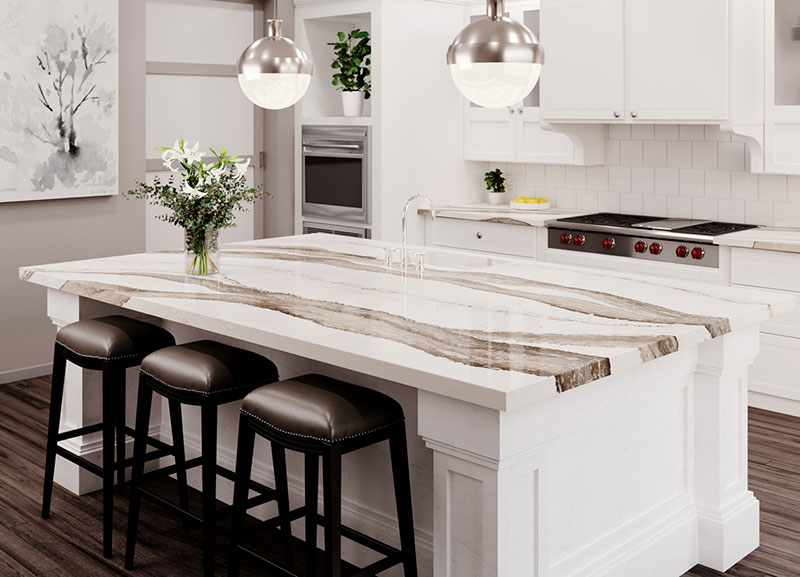
When it comes to creating a stylish and sustainable kitchen in your San Diego home, Cambria Quartz stands out as a top choice for countertops. Known for its non-porous nature, this material is an eco-friendly option that offers a blend of beauty, durability, and hygiene.
As a countertop material, Cambria Quartz is made from one of the hardest minerals on earth – quartz. The manufacturing process involves combining approximately 93% natural quartz stone with small amounts of resin binder and pigment. This results in a product that is incredibly tough and resilient, able to withstand the wear and tear of daily kitchen activities.
The Benefits of Cambria Quartz
- Non-Porous: Unlike granite or marble, Cambria Quartz doesn’t require sealing or polishing. Its non-porous nature effectively resists absorption and prevents bacteria from penetrating its surface.
- Hygienic: By preventing bacteria growth, Cambria Quartz contributes positively to indoor air quality – an important factor for many homeowners.
- Eco-Friendly: Cambria Quartz is committed to environmentally responsible practices, including responsible quarrying, recycling of materials used during manufacturing, and maintaining certifications for safe food preparation.
The Beauty of Cambria Quartz
The aesthetic appeal of Cambria Quartz should not be underestimated either. With an array of colors and designs available, this material can suit any kitchen style – from traditional to modern.
So if you’re looking for an option that’s not only sustainable but also makes a bold design statement, Cambria Quartz could be just what you’re after.
2.5 Butcher-Block Countertops (Reclaimed Wood)
:max_bytes(150000):strip_icc()/butcher-block-wood-countertop-farmhouse-kitchen-77a5138cd10342ca85ae0033c0c2be96.jpg)
Kitchens in San Diego homes are known for their style and sustainability, and Butcher-Block Countertops made from reclaimed wood perfectly embody these qualities. These countertops not only bring a warm, natural charm to your kitchen but also support the idea of sustainability.
The Beauty of Reclaimed Wood
Let’s take a moment to understand what ‘reclaimed wood’ really means. It refers to wood that has been previously used in old barns, warehouses, or factories and is now given a new purpose as your kitchen countertop. Each piece of wood used has its own unique history, character, and charm—every dent or scratch telling a story of its past life. By choosing reclaimed wood, you are actively reducing waste in landfills and the demand for new timber.
Durability and Repairability
These countertops are typically constructed from hardwoods like oak or maple, which are extremely sturdy. This means they can withstand the demands of daily kitchen activities while still maintaining their rustic charm.
One significant advantage of butcher-block countertops is their ability to be repaired. Unlike other materials such as granite or quartz, scratches and burns on wooden countertops can be sanded down and resealed, significantly extending their lifespan. And the best part? They only get better with age!
Benefits for the Environment
In terms of sustainability, using reclaimed wood helps combat deforestation—an urgent issue today—and reduces the air and water pollution caused by manufacturing new materials. It’s a countertop choice that not only looks great but also contributes to a better environment!
Considerations for Butcher-Block Countertops
Of course, like any material, there are some things to keep in mind when choosing butcher-block countertops:
- Sealing: To protect against water damage and stains, these countertops require regular sealing.
- Maintenance: They need to be oiled periodically to maintain their shine and prevent drying out.
- Heat Sensitivity: Avoid placing hot pots directly on the surface as it can leave scorch marks.
Despite these factors, many homeowners find that the beauty and eco-friendly nature of butcher-block countertops outweigh the minor maintenance efforts.
3. Environmentally Friendly Flooring Options
When it comes to kitchen renovations, the flooring choice can make a significant impact not just on the look and feel of the space, but also on the environmental footprint of your home. Two standout materials in the realm of sustainable flooring are cork and bamboo.
3.1 Cork Flooring

Cork is a remarkable material that offers a host of benefits for those looking to make eco-friendly choices:
- Renewable Resource: Cork is harvested from the bark of cork oak trees which regrow their bark every 9 years, making it an endlessly renewable resource.
- Comfort and Resilience: Due to its cellular structure, cork floors are naturally resilient and comfortable underfoot. They provide excellent insulation against heat, cold, and even sound.
- Durability: Kitchens are high-traffic areas, but cork flooring handles it well with its ability to ‘bounce back’, reducing the appearance of dents or scratches.
- Health Benefits: Cork is naturally hypoallergenic, repelling dust, hair, and other small particles – a boon for indoor air quality.
- Easy Maintenance: A simple sweep or vacuum followed by a damp mop is all that’s needed to keep cork floors looking fresh.
Cork flooring isn’t just about being kind to the planet; it’s also about bringing a warm and inviting aesthetic to your kitchen. With various colors and patterns available, it can fit into any design scheme from rustic to contemporary.
It’s no wonder that homeowners in San Diego are turning towards materials like cork for their remodeling projects. Not only does it align with environmental values, but it also adds unparalleled comfort and style to one of the most important rooms in the house.
3.2 Bamboo Flooring
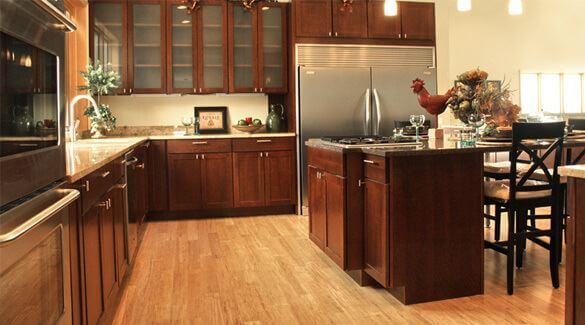
When it comes to sustainable flooring for San Diego kitchens, bamboo flooring stands out as an exceptional option. Its reputation for strength and durability makes it a savvy choice for areas like the kitchen, which see plenty of foot traffic and activity.
Rapid Renewability
Bamboo is a highly renewable resource, growing to maturity in as little as three to five years—far quicker than hardwood trees, which can take twenty years or more. This rapid growth cycle means that bamboo can be harvested frequently without causing damage to the ecosystem, making it a poster child for renewable resources in home design.
Durability
Bamboo’s natural characteristics include a strong fiber structure, which makes it incredibly tough and resilient against wear and tear. In fact, when properly treated and manufactured, bamboo flooring can be harder and more durable than some traditional hardwoods. It’s this robustness that ensures your kitchen floor can withstand the comings and goings of daily life, from spills and drops to the scurry of pet paws.
Design Flexibility
- Bamboo flooring offers a sleek and contemporary look that can elevate any kitchen design.
- It comes in a variety of shades and grains, allowing homeowners to customize their space according to their personal aesthetic preferences.
- The material also works well with various finishes, giving it the versatility to fit into a myriad of interior styles.
Environmentally Friendly Choice
Choosing bamboo flooring isn’t just about aesthetics or functionality; it’s also an environmentally conscious decision. Bamboo plants absorb carbon dioxide and release oxygen at a higher rate compared to many other plants, which contributes positively to air quality. Plus, because bamboo requires no fertilizers or pesticides to thrive, its cultivation has minimal environmental impact.
Maintaining Bamboo Floors
- Easy to clean with just a sweep or vacuum, followed by a damp mop.
- Resistant to moisture when properly sealed, making them suitable for kitchens where spills are common.
- Although resistant to wear, care should be taken to protect from scratches and dents with proper furniture pads.
San Diego homeowners looking for sustainable kitchen materials need look no further than cork and bamboo flooring options. Both offer unique benefits that contribute not only to an eco-friendly home but also create a warm and inviting atmosphere in one of the most important rooms of the house—the kitchen. Transitioning next into energy-efficient appliances will further solidify your commitment to sustainability throughout your kitchen remodel.
4. Energy-Efficient Appliances
When it comes to creating an eco-friendly kitchen in your San Diego home, choosing energy-efficient appliances is a win-win situation. Here’s why they’re so beneficial:
1. Reduction in Greenhouse Emissions
Energy-efficient appliances are designed to use less energy while still performing at their best. This means they play a crucial role in reducing greenhouse gas emissions by minimizing the amount of energy needed for their operation. As a result, there is less reliance on fossil fuels at power plants, leading to a cleaner environment.
2. Cost Savings
While energy-efficient appliances may have a higher upfront cost, they prove to be cost-effective in the long run. By utilizing innovative technologies to conserve energy, these appliances can significantly lower your utility bills over time, making them a wise investment for homeowners on any budget.
3. Smart Features for Added Convenience
Beyond their energy-saving benefits, modern energy-efficient appliances also come with smart features that enhance convenience and performance. Some examples include:
- Refrigerators with sensors that adjust cooling settings based on the amount of food inside
- Ovens using advanced heating mechanisms for more even cooking with less heat
- Dishwashers with efficient water usage and customizable wash cycles
These smart technologies not only make our lives easier but also contribute to a greener lifestyle.
“You’re cooking up a storm in your kitchen, and every appliance from your dishwasher to your stove is working tirelessly yet efficiently, without wasting a watt.”
This vision of an energy-efficient kitchen paints a picture of sustainability and responsible consumption. It shows how our choices can positively impact the environment without compromising on functionality or style.
Whether you’re boiling water for pasta or keeping your produce fresh in the fridge, these appliances are designed to support you in every culinary endeavor while minimizing your ecological footprint.
So let’s make the switch to energy-efficient appliances and embrace a more sustainable way of living, starting right in our own homes!
5. Sustainable Kitchen Products
Creating a sustainable kitchen environment goes beyond just the materials and appliances you choose. It extends to the everyday products you use, from cleaning solutions to the items that help you avoid waste. Here, let’s dive into some of these game-changers for any eco-conscious San Diego homeowner.
5.1 Green Cleaning Products

Using green cleaning products is like giving your kitchen a breath of fresh air. These products are crafted to be kind to the planet, often made with biodegradable ingredients that break down naturally without leaving harmful residues behind.
- Healthier Home Environment: Unlike conventional cleaners, eco-friendly options skip the harsh chemicals, reducing the risk of health issues like skin irritation or respiratory problems.
- Safety for Wildlife and Waterways: When you rinse off these cleaners, they’re less likely to harm aquatic life or disrupt ecosystems as they’re processed through water treatment facilities.
- Packaging Considerations: Many green brands prioritize recycled or recyclable packaging, further cutting down on plastic waste.
Embracing these cleaners means sparkling countertops and gleaming floors without the environmental guilt. Plus, many local San Diego stores offer a selection of these products, making it easy to stock your shelves with earth-friendly options.
5.2 Reusable Items
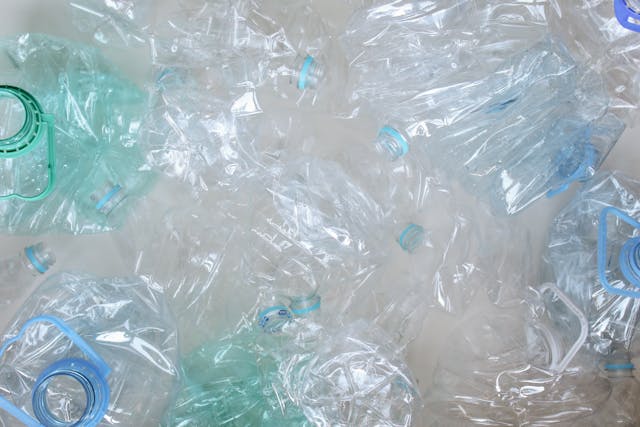
The mantra “reduce, reuse, recycle” finds a perfect home in sustainable kitchens. Swapping disposable goods for reusable alternatives is a simple yet effective way to minimize waste.
1. Swap Out Plastic Water Bottles
For starters, consider those plastic water bottles that pile up in the recycling bin. It’s easy to swap them out with a chic, stainless steel or glass water bottle. Not only do they look great on your countertop, but they also eliminate the need for disposable plastic bottles. Just imagine the mountain of plastic you could divert away from landfills!
2. Choose Tupperware and Glass Containers
Similar changes can be applied to food storage. Tupperware and glass containers are excellent alternatives to single-use plastic bags and wrap. They’re perfect for storing leftovers, packing lunches, or even organizing ingredients in your pantry. What’s more, they are dishwasher safe – easy cleaning without adding to your chores.
3. Bring Your Own Shopping Bags
Shopping bags are another area where you can make a significant impact. Instead of accepting paper or plastic bags at the store, bring your reusable shopping bags. They’re sturdy, hold more items, and best of all — they reduce waste.
4. Use Eco-Friendly Cleaning Products
When it comes to cleaning up after meal prep or dining, opt for green cleaning products specifically designed for kitchen use. These eco-friendly cleaners effectively banish grime and dirt without harming your health or our planet.
5. Invest in Energy-Saving Appliances
No discussion on holistic sustainability would be complete without mentioning energy-saving appliances such as LED lighting and Energy Star-rated devices. These appliances consume less power compared to their conventional counterparts, lowering your energy bills while reducing carbon emissions.
Remember that every step you take towards a more sustainable kitchen helps create a healthier home and a happier planet! By incorporating reusable items into your daily routine along with choosing sustainable materials, you’re setting an example for others in San Diego to follow.
5.3 Energy-Saving Appliances
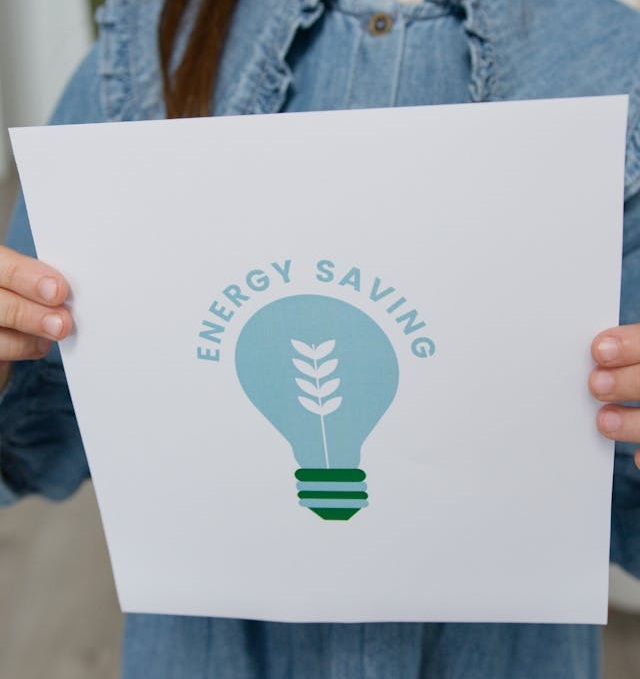
When it comes to making our kitchens more sustainable, energy-saving appliances are a game-changer. They do more than just reduce our electricity bills—they also help minimize the environmental harm caused by kitchens. These appliances are designed to use less energy while still performing well, resulting in fewer harmful emissions being released into the atmosphere.
It’s amazing how much progress has been made in technology. Today’s refrigerators, dishwashers, and ovens are equipped with smart features that optimize their energy consumption. Here are some examples:
- Refrigerators: Look for models with an Energy Star rating. They use advanced insulation technology and more efficient compressors that keep food cold without using excessive energy.
- Dishwashers: Newer dishwashers have soil sensors to adjust the cycle length and water usage depending on how dirty the dishes are, leading to significant water and energy savings.
- Ovens: Convection ovens circulate air to cook food more evenly and usually at a lower temperature—and faster too—saving energy in the process.
These energy-saving appliances for the kitchen are not only practical but also stylish. They come in designs that can seamlessly blend into any kitchen aesthetic while being environmentally friendly.
Making Sustainable Choices with Smaller Kitchen Tools
In addition to choosing energy-efficient major appliances, it’s important to consider the impact of smaller tools that we use on a daily basis. Here are two examples:
- An electric kettle with an automatic shut-off feature avoids unnecessary electricity use.
- Programmable coffee makers ensure you’re not heating water longer than needed.
By being mindful of these choices, we can further reduce our energy consumption in the kitchen.
The Importance of Green Cleaning Products
To complement your selection of appliances, it’s worth incorporating green cleaning products into your cleaning routine. These products often contain ingredients that are less harmful to the environment, particularly our oceans and marine life—an important consideration for San Diego’s coastal community.
The Value of Reusable Items in an Eco-Friendly Kitchen
Another way to minimize waste in your eco-friendly kitchen is by using reusable items such as silicone baking mats or beeswax wraps. These alternatives to single-use products like aluminum foil or plastic wrap can make a significant difference in reducing the amount of trash generated.
This commitment to holistic sustainability extends beyond just choosing energy-efficient appliances; it involves creating a kitchen where every aspect is carefully evaluated for its environmental impact—from the materials used for the flooring to the type of lighting installed.
Conclusion
When it comes to a San Diego home renovation, especially the heart of your home—the kitchen—every choice counts. Opting for sustainable kitchen materials is more than a trend; it’s a commitment to taking care of our planet and our health in our homes. The materials and finishes you choose can create a kitchen that’s not just nice to look at, but also shows that you care about the environment and making responsible choices.
Here are some key points to remember:
- Make Conscious Choices: From cabinets made of MDF or bamboo to countertops that repurpose materials like recycled paper and glass, these sustainable options do wonders for both your home’s aesthetic and the environment.
- Durability Meets Design: Eco-friendly doesn’t mean compromising on quality or style. With the advancements in sustainable materials, durability is hand-in-hand with sleek, modern designs.
- Healthier Living Space: By choosing low-VOC paints and non-porous surfaces, you contribute to healthier indoor air quality for you and your family.
- Energy Efficiency: Pair your material selections with energy-saving appliances for a kitchen that truly embodies sustainability.
Don’t hesitate to explore the world of eco-friendly kitchen design. Share your journey toward sustainability with others; your experiences can inspire more San Diego homeowners to embrace green living. Remember, with each sustainable choice, we’re creating not only beautiful kitchens but also a better future.
FAQ
Q1: What are some environmentally friendly cabinet options?
A1: Some eco-friendly cabinet options include MDF (Medium Density Fiberboard), Bamboo, NuGreen Particleboard, and cabinets finished with Water-Based Paints and Stains.
Q2: What are some eco-friendly countertop options?
A2: Eco-friendly countertop materials include PaperStone (Recycled Paper), IceStone (Recycled Glass and Concrete), Dekton (Sintered Surface), Cambria Quartz (Non-Porous Stone), and Butcher-Block Countertops made from reclaimed wood.
Q3: Can I use environmentally friendly materials for flooring?
A3: Yes, you can. Some sustainable flooring options are Cork Flooring and Bamboo Flooring.
Q4: Are there any energy-efficient appliances I could incorporate into my kitchen design?
A4: Absolutely! Energy-efficient appliances not only reduce greenhouse emissions but also offer cost savings and smart features for added convenience.
Q5: Are there specific products that can make my kitchen more sustainable?
A5: Yes, consider using green cleaning products, reusable items, and energy-saving kitchen gadgets to make your kitchen more eco-friendly.
Q6: Can choosing eco-friendly options contribute to a healthier living space?
A6: Definitely. By choosing low-VOC paints and non-porous surfaces, you contribute to healthier indoor air quality for you and your family.
Q7: Can I maintain a modern aesthetic while choosing sustainable options for my kitchen design? A7: Absolutely! Eco-friendly doesn’t mean compromising on quality or style. With advancements in sustainable materials, durability goes hand-in-hand with sleek, modern designs.
Q8: What is the overall benefit of making conscious choices in kitchen design? A8: In addition to creating a beautiful and functional space, these sustainable choices help protect the environment, promote healthier living spaces, and contribute to a better future.